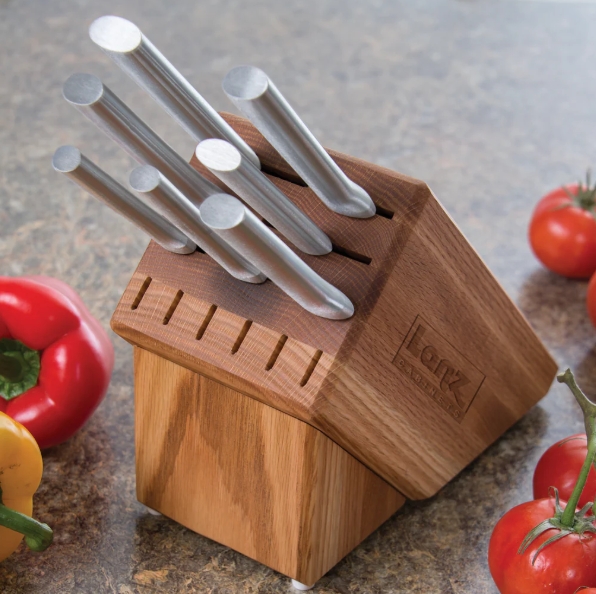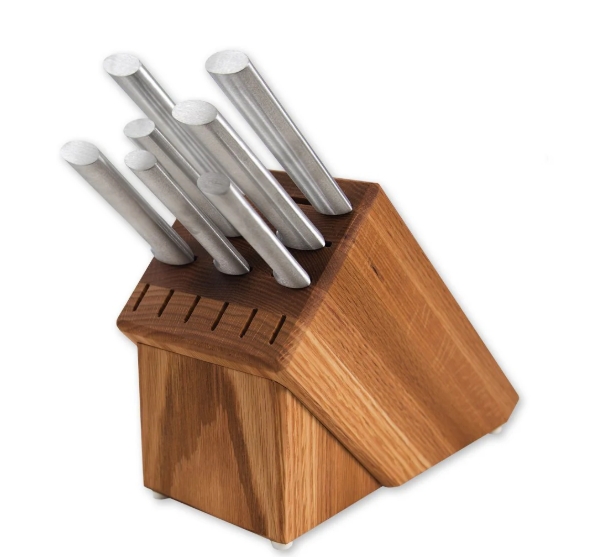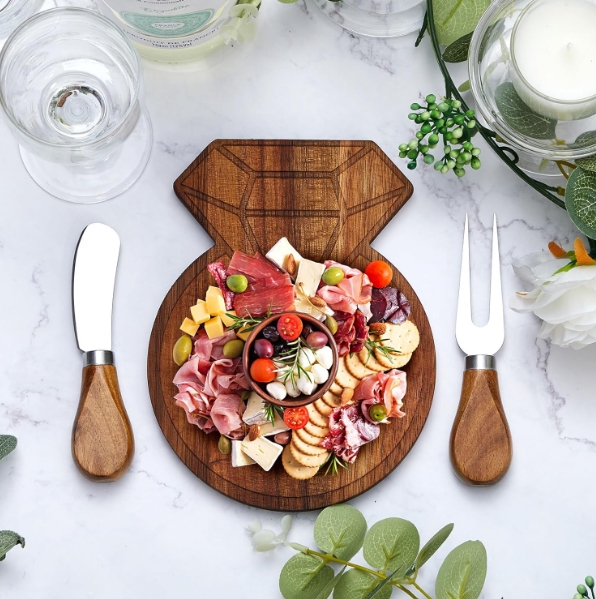

Views: 222 Author: Ella Publish Time: 2025-05-01 Origin: Site








Content Menu
● Understanding Knife Blade Types
>> Common Blade Types and Their Uses
>> Chef's Knife
>> Paring Knife
>> Bread Knife
● Specialty Knives: When and Why You Need Them
● Factors to Consider When Choosing a Knife Set
>> 1. Your Cooking Style and Needs
>> 3. Blade Quality and Material
>> 4. Maintenance Requirements
● Blade Materials and Construction
● Knife Set Configurations: From Basic to Professional
>> Basic Sets
>> Full Sets
● FAQ: Top 5 Questions About Choosing Knife Sets
>> 1. What are the three most essential knives every kitchen should have?
>> 2. Should I choose a Western or Japanese knife set?
>> 3. How do I know if a knife set is high quality?
>> 4. How many knives do I really need in a set?
>> 5. How should I store my knives to keep them sharp and safe?
Selecting the perfect knife set is one of the most important decisions for anyone passionate about cooking, whether you're just starting out, a dedicated home cook, or a seasoned professional chef. The right combination of blade types in your knife set can transform your kitchen experience, making food preparation faster, safer, and more enjoyable. This comprehensive guide will walk you through everything you need to know to choose a knife set with the right blade types, from understanding the essential knives to considering materials, ergonomics, and maintenance.

The world of kitchen knives is vast, with each blade type designed for specific tasks. Knowing the purpose and advantages of each blade will help you assemble a set that matches your cooking style.
- Chef's Knife: The all-purpose workhorse, ideal for chopping, slicing, and dicing a wide variety of ingredients.
- Paring Knife: Small and nimble, perfect for peeling, trimming, and precision tasks.
- Bread Knife: Features a long, serrated edge to slice through crusty bread and delicate cakes without crushing them.
- Utility Knife: A mid-sized knife for miscellaneous tasks, from slicing sandwiches to cutting cheese and small fruits.
- Santoku Knife: A Japanese-style multipurpose knife, excellent for slicing, dicing, and mincing, especially vegetables.
- Nakiri Knife: Rectangular and thin, designed specifically for chopping vegetables with clean, straight cuts.
- Boning Knife: Thin and flexible, used for deboning meat and fish.
- Carving Knife: Long and slender, made for slicing cooked meats thinly and evenly.
- Cleaver: Heavy and broad, ideal for chopping through bones and tough ingredients.
While there are dozens of specialty knives, most home cooks only need a few core blades. Here's a breakdown of the essential knives every set should include:
The chef's knife is the most versatile blade in any kitchen. Its broad, curved edge allows for rocking motions, making it ideal for chopping, dicing, and mincing everything from herbs to meats. Western chef's knives tend to be heavier and more curved, while Japanese versions (like the Gyuto) are lighter and sharper, excelling at precision tasks.
This small knife is indispensable for tasks that require control and delicacy, such as peeling apples, deveining shrimp, or cutting small garnishes.
A serrated bread knife is essential for slicing through crusty loaves, bagels, and even delicate tomatoes without crushing them.
Falling between a chef's knife and a paring knife, the utility knife is perfect for medium-sized tasks-think slicing sandwiches, cheese, or small vegetables.
If you prepare a lot of vegetables, a Santoku or Nakiri knife can be a game-changer. Their straight edges and thin blades make quick work of slicing and dicing produce.

As your skills and culinary interests grow, you may want to add specialty knives to your set. Here are some common options and their uses:
- Boning Knife: For deboning poultry, meat, and fish with precision.
- Fillet Knife: Extra flexible for filleting fish.
- Carving Knife: For slicing roasts, turkey, and large cuts of meat.
- Cleaver: For heavy-duty chopping and breaking down bones.
- Steak Knives: For table use, especially if you serve meats frequently.
- Tomato Knife: Serrated and small, perfect for slicing tomatoes and other soft produce.
Before purchasing a knife set, assess your cooking habits. Do you mostly cook vegetables, meats, or a mix of both? Are you a beginner, home cook, or professional? Do you need a basic set or a comprehensive collection with specialty knives? Understanding your cooking style will help you prioritize which knives are essential for your kitchen.
A knife should feel balanced and comfortable in your hand. Handle materials (wood, plastic, resin, metal) and shapes vary, so try holding different knives to find what suits you best. The weight and balance of a knife can affect your efficiency and safety in the kitchen. A well-designed handle reduces fatigue and risk of injury during extended use.
- Stainless Steel: Durable, rust-resistant, and easy to maintain.
- Carbon Steel: Holds a sharp edge longer but requires more care to prevent rust.
- Damascus Steel: Known for its unique patterns and excellent sharpness, often used in high-end knives.
- Laminated Steel: Combines hard core steel with softer outer layers for durability and ease of sharpening.
The quality of the blade material impacts sharpness, edge retention, and maintenance needs. High-carbon stainless steel is a popular choice for its balance of sharpness and corrosion resistance.
Some knives require more frequent sharpening and careful cleaning. Consider how much time you're willing to invest in maintenance. Knives made from harder steel may hold their edge longer but can be more challenging to sharpen. Regular honing and periodic sharpening are necessary to keep any knife performing at its best.
Knife sets range from a few essential pieces to comprehensive collections. Choose a set that matches your needs and available storage space. Many sets come with a knife block, magnetic strip, or in-drawer tray for safe storage. Proper storage protects the blades and prevents accidents.
Knife sets are available at various price points. While it may be tempting to opt for the most affordable set, investing in a high-quality set can save money in the long run by lasting longer and performing better. Consider your budget but prioritize value, quality, and the types of knives you will actually use.
The material and construction of a knife blade determine its sharpness, durability, and ease of maintenance.
- Forged Steel: Made from a single piece of steel, offering superior strength and balance. Forged knives are typically heavier and more durable.
- Stamped Steel: Cut from a sheet of steel, usually lighter and more affordable, but may not hold an edge as long. Stamped knives can be a good choice for lighter kitchen tasks or as budget-friendly options.
- Double Bevel: Sharpened on both sides, common in Western knives, suitable for most users.
- Single Bevel: Sharpened on one side, found in traditional Japanese knives, offering extreme sharpness for precision tasks.
The type of edge affects cutting performance and maintenance. Double bevels are easier to use and maintain, while single bevels provide exceptional sharpness for specialized tasks.
The handle affects grip, comfort, and control. Materials include:
- Wood: Classic look and feel, but may require more care. Wooden handles can be affected by moisture and may need periodic oiling.
- Plastic/Resin: Durable and resistant to moisture. These handles are easy to clean and maintain, making them practical for busy kitchens.
- Metal: Modern and sturdy, but can be slippery if not textured. Metal handles offer durability but may not provide the same comfort as other materials.
Look for handles that fit comfortably in your hand and provide a secure grip, especially when wet. Ergonomic handles reduce hand fatigue and improve safety.
Include a chef's knife, paring knife, and bread knife. Perfect for beginners or minimalists who want to cover the most common kitchen tasks without clutter.
Add utility, Santoku, or Nakiri knives, and sometimes include steak knives, honing steel, and kitchen shears. Ideal for home cooks who want versatility and the ability to tackle a wider variety of recipes.
Feature specialty knives (boning, fillet, carving, cleaver), often with higher-grade materials and more pieces. Best for serious cooks and chefs who require specialized tools for advanced techniques.
When selecting a configuration, consider your kitchen space, budget, and the types of meals you prepare most often.
Proper care extends the life and performance of your knives:
- Hand Wash Only: Never put knives in the dishwasher; it can dull blades and damage handles.
- Dry Immediately: Prevent rust and water spots by drying knives right after washing.
- Sharpen Regularly: Use a whetstone or professional sharpening service to maintain a razor-sharp edge.
- Use a Honing Steel: Regular honing keeps the edge aligned between sharpenings.
- Store Safely: Use a knife block, magnetic strip, or sheath to protect blades and prevent accidents.
Additionally, consider investing in a quality knife sharpener and honing rod to keep your blades in top condition. Regular maintenance not only preserves sharpness but also ensures safety during use. Avoid cutting on hard surfaces like glass or stone, as these can quickly dull your knives. Instead, use wooden or plastic cutting boards to prolong blade life.
Proper cleaning and drying are crucial for preventing corrosion, especially on high-carbon steel knives. Always store your knives in a way that protects the blade edge and keeps them safely out of reach of children. If you travel with your knives or need to store them temporarily, use blade guards or knife rolls for extra protection.
Choosing a knife set with the right blade types is about understanding your cooking habits, the tasks you perform most, and your preferences for materials and ergonomics. Start with the essentials-a chef's knife, paring knife, and bread knife-then expand your set as your culinary skills and interests grow. Invest in quality over quantity, and remember that proper care and maintenance will keep your knives performing at their best for years to come.
A thoughtfully chosen knife set can elevate your cooking, making every meal preparation more efficient and enjoyable. Take the time to research, handle different knives, and consider your unique needs before making your selection. With the right set, you'll be equipped to handle any culinary challenge that comes your way.

The three most essential knives are the chef's knife (for general chopping and slicing), the paring knife (for small, precise tasks), and the bread knife (for cutting bread and other foods with tough exteriors and soft interiors).
Western knives are typically heavier, more curved, and made from softer steel, making them more durable for tough tasks. Japanese knives are lighter, sharper, and excel at precision work, especially with vegetables and fish. Choose based on your cooking style and the foods you prepare most often.
Look for forged blades (rather than stamped), high-quality steel (such as stainless or Damascus), full tang construction (the blade extends through the handle), and comfortable, well-balanced handles. Brand reputation and warranty can also indicate quality.
Most home cooks can handle almost any task with three to five knives: chef's, paring, bread, utility, and possibly a Santoku or Nakiri for vegetables. Only add specialty knives as your needs become more specific.
Store knives in a knife block, on a magnetic strip, or in a dedicated drawer tray. Avoid tossing them in a drawer, as this can dull the blades and create safety hazards.